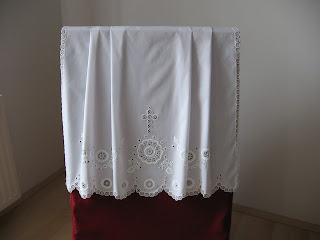I was given my first piece of Hövej embroidery back in 1997. I didn't know where it had come from or what kind of embroidery it was, I just thought it was beautiful. Over the next several years my mother and I collected several more pieces and eventually we learned that these beautiful pieces were handmade in Hövej.
Earlier this year, I wrote an article for Ellen Chester's newsletter, With My Needle and Pen, and decided at that time to go searching for some information on Hövej embroidery on the internet. I came across a website that I had not seen before - Mrs. Szigethy's website. Since it was written in English, I took a chance and hit the "contact us" button in pursuit of learning more. Mrs. Szigethy's daughter, Elisabeth, responded to me and over the past several months we formed a friendship. When an invitation was extended to come stitch with Mrs. Szigethy, I decided that there was no time like the present!
As you saw in my last post, we first visited Mrs. Szigethy's exhibit in Hövej. At the exhbit, there was a display that provided some insight into how the embroidery is done.
First, you must understand that Hövej embroidery is only done by women who live or have lived in Hövej. This art is passed down from one generation to the next generation. There are no instruction books per se; but there are patterns which were designed by the original women who introduced the embroidery. In the early 1900's, the women of the village would work all day and then would gather at night stitching by the light of gas lamps to complete their pieces. As they stitched and talked, they would sometimes create new patterns for their designs. Today, there are approximately 15 - 20 women who are skilled at this form of embroidery; and as you saw in an earlier post, there are others who are interested in learning it.
You begin with one of the patterns which is drawn on paper; here are some of the patterns that were in the display:
After selecting the pattern you are going to use, you place your fabric over it and trace the design onto the fabric. The fabric is usually organza or a very fine cotton...
Once your design has been traced on the fabric, then your fabric is stretched onto a wooden frame, like this:
And then you begin to stitch. The embroidery is always white on white. Mrs. Szigethy used Anchor threads. As you complete your stitching the fabric in the holes must be cut out. I expected to see a small fine embroidery scissors, but instead, Mrs. Szigethy used a larger scissors - it's all she's ever known!
And as mentioned earlier, oftentimes, the women would stitch late into the evening by the light of gas lamps (sorry for the angle of this photo).
As you can see, the holes are then filled with spidery like filling stitches. Usually the larger holes will be filled with a different filling stitch. The technique used to complete these filling stitches was needlelace. After all stitching is complete, the fabric around the design is cut away.
Mrs. Szigethy was born in 1929. She took interest in her mother's stitching when she was about 7 years old. By age 10 she had learned how to do it and would stitch everyday. Her father died at about this time and she helped to support the family by creating beautiful embroidered doilies and tablecloths that could be sold to help earn money.
When Mrs. Szigethy was 25 years old she married and left Hövej to move to another nearby village. She did not leave the embroidery behind. 20 months after she married, her husband died and left her with a 3 month old daughter to raise. Mrs. Szigethy continued to sell her embroidery but it wasn't enough to support her and her daughter. She left her daughter with grandparents and went to Budapest to study and became a midwife. As a midwife, she delivered 22 babies in the village she lived in. She then later worked as a nurse at the local hospital, married again and had two more children. Her youngest child died very young. Through all this time she continued to embroider as the extra income helped to support the family and allowed both of her daughters to attend school (university).
I asked Mrs. Szigethy to tell me about the largest piece she ever embroidered. She and three other women were asked to embroider the tablecloth that was used at the celebration of Stalin's 70th birthday. The tablecloth was 8 meters long (about 26 feet) by 3 meters wide (about 10 feet).
Mrs. Szigethy does not sell her embroidery anymore. She does it simply for the joy of doing it and gives many of her pieces away. In 2011, Mrs. Szigethy was awarded Hungary's highest honor, Master of Folk Art, for her lifelong dedication to Hövej embroidery!
I had the good fortune of spending two afternoons with Mrs. Szigethy. She was a sweet lady. She loves to embroider and she loves sharing her talent with others.
We could not speak with each other, but Elisabeth, her daughter, helped by translating. Mrs. Szigethy would first demonstrate...
And then it was my turn...
We worked back and forth like that. I was delighted to hear her say "ja, ja" (it sounded more like "jo, jo") because that meant I was doing it correctly!
I was fascinated that she could work on such delicate fabric with such a large scissors!
On the second afternoon, we worked on filling one of the large holes...
And then it was my turn...(Chris C - note how long that thread was -- I was thinking of you!)
This visit was so special and I will treasure the experience as long as I live. I hope that I will have the opportunity to visit again with Mrs. Szigethy!








































































